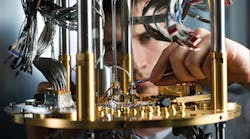Some technology watchers are predicting that quantum computing will be a major driver of innovations and advances in a wide range of disciplines over the coming decades. To get a better idea of quantum technology’s true potential, scientists and researchers need to work with it. Unfortunately, quantum computers are few and far between.
To rectify that lack of hardware, management at Sandia National Laboratories have built an open-access quantum computing testbed, the Quantum Scientific Computing Open User Testbed (QSCOUT). Researchers from academia, the government and commercial companies will be able to freely access QSCOUT to get hands-on experience using quantum computers. This initiative also eliminates the cost and restrictions of relying on commercial testbeds.
“QSCOUT serves a need in the quantum community by giving users the controls to study the machine itself, which aren’t yet available in commercial quantum computing systems,” says Sandia physicist and QSCOUT lead Susan Clark. “It also saves theorists and scientists from the trouble of building their own machines. We hope to gain new insights into quantum performance and architecture as well as solve problems that require quantum computation.”
Unlike most commercial testbed for quantum computing which use superconducting circuits, QSCOUT uses an ion trap. Superconducting circuits must be kept at ultra-low temperatures, making them expensive to build and operate. Ion traps not only run at a higher temperature, which brings costs down, but also output clearer signals and hold on to information longer. This lets researchers perform different types of experiments and compare results.
Trapped ions are held inside QSCOUT in a “trap on a chip,” a flat, bow tie-shaped device, about 0.8 in. (2 cm) long, on top of a semiconductor chip. Radio waves and an electric field hold three electrically charged atoms of ytterbium suspended above a hairline channel running down the center of the chip. To carry out calculations, lasers encode information in each ion as a qubit, comparable to a bit in conventional computers. Sandia plans to expand the computer from three to 32 qubits over the next three years so it can handle more sophisticated tests.
Last month, Sandia ran the testbed’s first experiment for scientists from Indiana University. Teams from IBM, Oak Ridge National Laboratory, the University of New Mexico and the University of California, Berkeley are scheduled to begin experiments soon. Their projects range from testing benchmarking techniques to developing algorithms to solve chemistry problems too complex for conventional computers (even the supercomputer variety).
Sandia is opening the doors for more research proposals and anyone can submit proposals to use OSCOUT. The computing time is free, thanks to funding from the DOE Office of Science, Advanced Scientific Computing Research program. The next group of projects is expected to be selected in the spring.
QSCOUT resides at Sandia’s Microsystems Engineering, Science and Applications complex in Albuquerque, N.M., which also produces microelectronics for the nation’s nuclear stockpile. Researchers interested in using OSCOUT can sign up for notifications via email.
